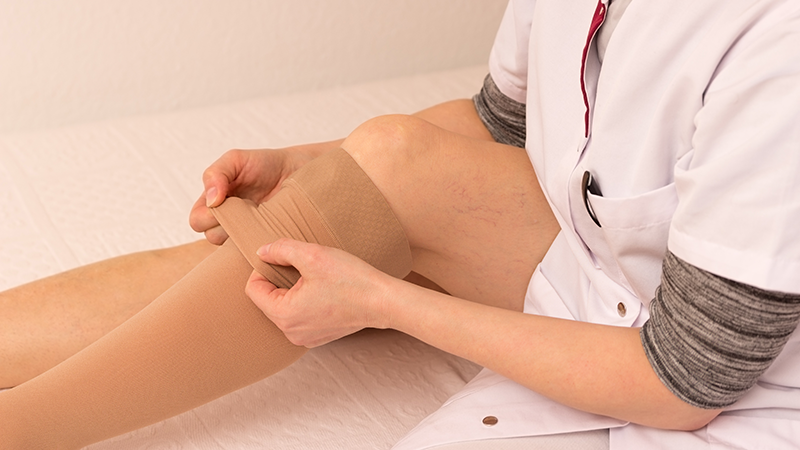Those varicose veins in your legs are not only unattractive, they can be an indicator of a more serious health issue. And if you have swelling around protruding leg veins, you need to see a physician.

Chronic swelling or edema is often caused by poorly functioning veins. These veins have lost their ability to push blood from the feet back up to the heart, resulting in pooling of blood and fluid in the feet, ankles and lower legs.
Pooling of blood and fluid in the feet, ankles and lower legs are aggravated by prolonged standing or sitting with the legs hanging down. This forces these poorly functioning veins to now have to attempt to pump the blood against gravity. This adds additional strain to already stressed blood vessels.
Since, unfortunately, there is no cure for these dysfunctional veins, the physicians at the Johnson Memorial Health Wound Healing Center treat leg vein disease with different options – including leg wraps. The compression – especially when there is swelling – often helps avoid more serious complications.
Here are three ways to control the swelling when you have leg vein disease.
Elevate Your Legs
Chronic swelling Is best managed by giving these veins a rest. At regular intervals throughout the day, time should be taken to lie flat and elevate your feet so that they sit higher than your heart. This assists those poorly functioning veins to help drain the blood and fluid from the feet, ankles and lower legs, since In this position the blood is now flowing "downhill".
It is important to remember that while standing in one place should be avoided, walking can be helpful. Exercising the calf muscle while walking can help "pump" the fluid out of the lower leg. Therefore, take short walks throughout the day to manage these incompetent veins.
Wear Compression Stockings
Compression stockings are specially designed to help control swelling in the feet, ankles and lower legs. These stockings squeeze these areas to prevent the build up of fluid In the tissue. This build-up of fluid creates a high degree of pressure within the feet, ankles and lower legs, which can be very painful.
This fluid also prevents blood from circulating to the skin surface where the wound Is located, and therefore slows down the healing process considerably.
Once your wound has healed, your physician will recommend continue wearing the compression stockings to keep your swelling under control. This also will help reduce the chance of developing a new wound in the future.
It is also important to know that compression stockings come in various strengths, some which require a prescription. Others may be purchased over the counter at the pharmacy. It Is critical to use the strength of stocking recommended by your physician.
Use and Care for Compression Stockings
- Compression stockings must be gently applied slowly over the heel, and then gradually up the leg.
- In order to prevent holes or runs in your stockings, never pull or lug on them. Remove any jewelry that may interfere during application.
- Rubber kitchen gloves may be worn to improve the grip at your fingertips while working stockings up the leg. Avoid creases or wrinkles that may irritate the skin.
- Compression stockings must be applied first thing in the morning. These should be worn all day, but may be removed at bedtime, providing you sleep lying flat with your feet elevated on one or two pillows. They should be higher than your heart level.
- Compression stockings should be laundered in warm, soapy water. Check package inserts for more detailed instructions - different brands recommend different methods of care.
- Avoid having your stockings come in contact with petroleum-based ointments and lotions such as Vaseline. These products will damage the fibers.
- Compression stockings usually last approximately six months, depending on use and care.
Apply Multi-Layered Compression Wraps
Multi-layered compression wraps are specially designed bandages to help control swelling in the feet, ankles and lower legs. These wraps help prevent the build-up of fluid in the tissue, which can be very painful.
This fluid build-up also prevents blood from circulating to the skin surface and slows down the healing process.
Once your wound has healed, your physician will recommend that you continue some form of multi-layered compression wraps or stockings to keep swelling under control. This will help reduce the chance of developing a new wound in the future.
Use and Care for Multi-layered Wraps
- Multi-layered compression wraps should be applied one layer at a time in a circular manner, starting at the base of the toes and continuing up to just below the knee.
- Each circular layer of the wrap should be over-lapped by approximately 50 percent to prevent uneven application and bare patches where portions of the fool or leg may poke through.
- Creases or wrinkles should be avoided - as these may irritate the skin.
- The multi-layered compression wraps will be applied at the Wound Healing Center. Your physician will tell you when to return to change your multi-layered compression wraps at least once a week.
- Your multi-layered compression wraps may be uncomfortable, but they should not be painful when wearing.
If you experience pain and swelling from vein disease, please call the Johnson Memorial Wound Healing Center at 317.346.2700.
Learn More About Leg Vein Disease
